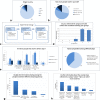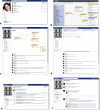Social support for collaboration and group awareness in life science research teams
- PMID: 31320922
- PMCID: PMC6615102
- DOI: 10.1186/s13029-019-0074-4
Social support for collaboration and group awareness in life science research teams
Abstract
Background: Next-generation sequencing (NGS) technologies have revolutionarily reshaped the landscape of '-omics' research areas. They produce a plethora of information requiring specific knowledge in sample preparation, analysis and characterization. Additionally, expertise and competencies are required when using bioinformatics tools and methods for efficient analysis, interpretation, and visualization of data. These skills are rarely covered in a single laboratory. More often the samples are isolated and purified in a first laboratory, sequencing is performed by a private company or a specialized lab, while the produced data are analyzed by a third group of researchers. In this scenario, the support, the communication, and the information sharing among researchers represent the key points to build a common knowledge and to meet the project objectives.
Results: We present ElGalaxy, a system designed and developed to support collaboration and information sharing among researchers. Specifically, we integrated collaborative functionalities within an application usually adopted by Life Science researchers. ElGalaxy, therefore, is the result of the integration of Galaxy, i.e., a Workflow Management System, with Elgg, i.e., a Social Network Engine.
Conclusions: ElGalaxy enables scientists, that work on the same experiment, to collaborate and share information, to discuss about methods, and to evaluate results of the individual steps, as well as of entire activities, performed during their experiments. ElGalaxy also allows a greater team awareness, especially when experiments are carried out with researchers which belong to different and distributed research centers.
Keywords: Life science teams collaboration; Social interactions; Working group awareness.
Conflict of interest statement
Competing interestsThe authors declare that they have no competing interests.
Figures



References
-
- Johansen R. GroupWare: Computer Support for Business Teams. New York: The Free Press; 1988.
-
- Gutwin C, Penner R, Schneider K. Proceedings of the 2004 Conference on Computer Supported Cooperative Work. New York: ACM; 2004. Group awareness in distributed software development.
-
- Afgan E, Baker D, Batut B, Van Den Beek M, Bouvier D, Ech M, Chilton J, Clements D, Coraor N, Grüning B, Guerler A, Jackson J, Hiltemann S, Jalili V, Rasche H, Soranzo N, Goecks J, Taylor J, Nekrutenko A, Blankenberg D. The galaxy platform for accessible, reproducible and collaborative biomedical analyses: 2018 update. Nucleic Acids Res. 2018;46(W1):537–44. doi: 10.1093/nar/gky379. - DOI - PMC - PubMed
LinkOut - more resources
Full Text Sources
Miscellaneous

